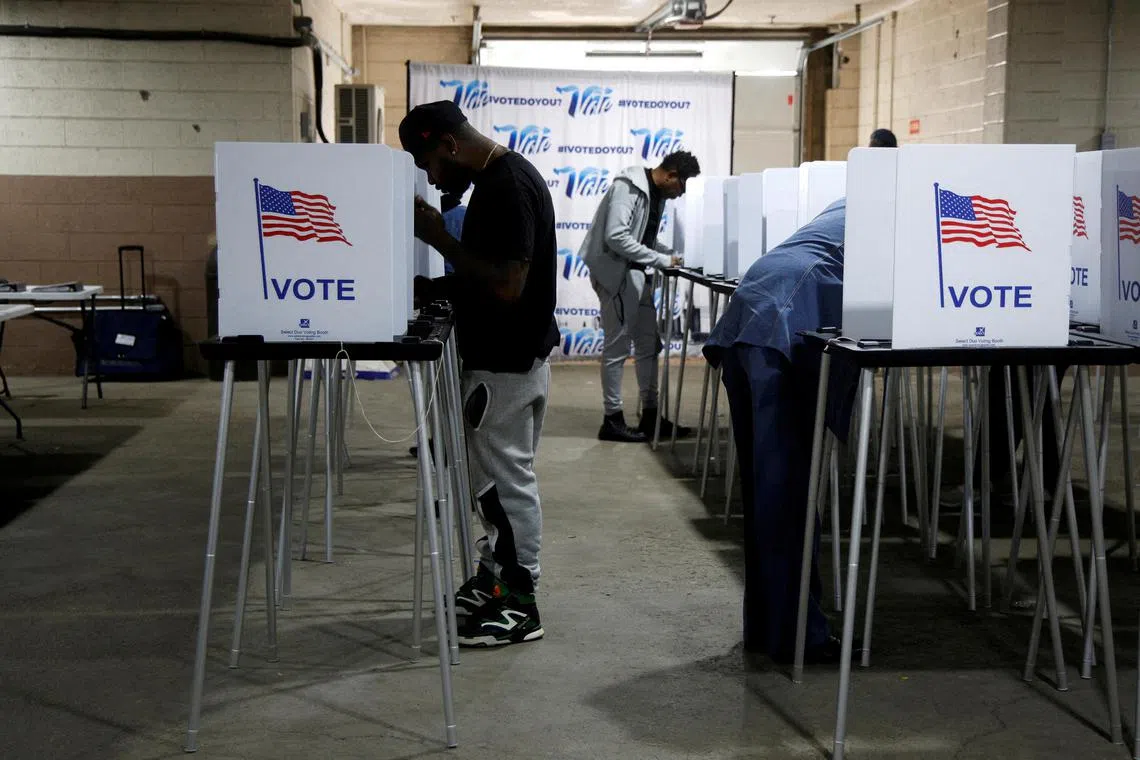Some late shifts, but US presidential polls remain closest they have ever been
Sign up now: Get ST's newsletters delivered to your inbox

Voters filling out ballots for the presidential election during early voting at the Detroit Elections Office on Oct 28.
PHOTO: REUTERS
Follow topic:
WASHINGTON - On Nov 4, the last day of the 2024 campaign, the polls showed one of the closest presidential elections in the history of American politics.
Nationwide or across the key battlegrounds collectively, neither Vice-President Kamala Harris nor former president Donald Trump led by more than a single percentage point. Neither candidate holds a meaningful edge in enough states to win 270 electoral votes.
In the history of modern polling, there has never been a race where the final polls showed such a close contest. If the poll averages are exactly right down to the decimal (they will not be), Ms Harris would barely need to outperform the polls to prevail.
The 2004 election between Mr John Kerry and Mr George W. Bush might be the next closest election in terms of polling, but it is hard to put it in quite the same tier. Even then, Mr Bush was a modestly clear favorite. Mr Kerry needed to win states such as Florida and Ohio, where Mr Bush held a consistent if narrow lead in the final polls.
This time, neither Trump nor Ms Harris faces such a narrow path to victory. In the key tipping point state in 2024’s pre-election polling – Pennsylvania – both candidates can point to several high-quality polls showing them tied or ahead. For good measure, they were both highly competitive in additional states, should Pennsylvania fall through.
Whether the final result will actually be as close as the polls showed is another matter. Even in an excellent year for polling, the polls tend to err one way or another, even if only by 1 or 2 points. When these subtle errors happen, it mostly goes unnoticed and the pollsters celebrate.
In 2024, even a relatively accurate year for polling might yield outcomes that feel very different. Do not be surprised if either candidate winds up winning in a manner that feels fairly decisive, such as by sweeping all of the battleground states and winning more than 300 electoral votes.
Of course, it is also possible that the polls will err by more than 1 or 2 points. If they do, it might yield an outcome that does not just feel decisive – it could also produce a surprisingly comfortable victory. Indeed, the poll errors from just the past two election cycles might be all it would take.
Even when there are no good reasons to expect the polls to be wrong, they can be. This time, there was no shortage of potential explanations.
If they do err, the range of possible outcomes is enormous. On the one hand, Democrats might still have an outside chance of winning the Senate and reclaiming full control of government. On the other, Republicans could win full control of government with a comfortable majority, including more than 55 seats in the Senate or more.
Although the race was fundamentally close all of October, it is pretty clear that the polls shifted towards Trump over the past few weeks
The national polls have become extremely close, raising the possibility of a Trump victory in the popular vote. And Ms Harris’ once clear-but-modest lead in the so-called blue wall of Pennsylvania, Wisconsin and Michigan has all but evaporated.
If you squinted, Trump narrowly took the lead in our averages in the middle of last week. He pulled ahead in Pennsylvania after seemingly weeks of polls showing the race tied or with him ahead. In the reckoning of the statistical forecasting models, this made Trump an ever-so-slight favorite.
But over the past few days, there were signs that the race had begun to swing a bit back toward Ms Harris:
- After a multiweek streak of high-quality polls showing Trump tied or ahead in Pennsylvania, Marist College, YouGov, Muhlenberg College and The Washington Post found Ms Harris narrowly up there.
-Then the Ann Selzer/Des Moines Register poll of Iowa – perhaps the most renowned public poll – found Ms Harris leading by 3 points in Iowa, a state that had been considered solidly Republican. (Trump carried the state handily in 2016 and 2020.)
– Finally, the last wave of New York Times/Siena College polls showed Ms Harris with a narrow edge in the key battlegrounds, including significant gains in the Sun Belt battlegrounds, as late-deciding voters said they were leaning her way.
Ms Harris’ gains came as the political conversation turned toward the former president’s liabilities. This included his rally at Madison Square Garden and his former chief of staff’s warning that he would rule like a dictator.
Although the news and the polls have helped give the Harris campaign a sense of momentum heading into election day, the overall effect on the averages has been relatively minimal. The race remains deadlocked. Historically, late shifts in the polls do not necessarily carry through to predict how the polls will err on election day.
In the end, the voters, not the polls, will soon have the final say. NYTIMES

